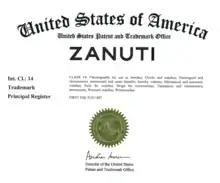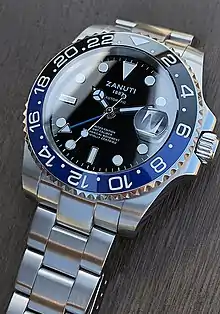Zanuti
ZANUTI INC. is a mechanical watchmaking company established in 1887 by Albert Favre Zanuti, currently headquartered in Tokyo (Japan) and with regional offices in Europe and the US.[1]
 | |
| Type | Private |
|---|---|
| Industry | Mechanical watchmaking |
| Predecessor | Zanuti & Cie. |
| Founded | 1887 |
| Founder | Albert Favre Zanuti |
| Headquarters | |
Area served | Worldwide |
| Products | Wristwatches |
| Website | zanuti.com |
The company was involved in the early development of the watchmaking industry in Japan, while being funded by a governmental program (O-yatoi Gaikokujin) promoting Japanese industrial and cultural reforms.[2][3]
Background
Zanuti was founded in 1887 as a result of 3 major events that took place in Japan during the second half of the 19th century.[4][5][6]
The first event was the establishment of the Commercial Treaty between Switzerland and Japan during a Swiss diplomatic mission to Asia in 1864, after more than 200 years of Japanese self-imposed isolation from international trade.[7]
This agreement signed in Japan by Swiss diplomat Aime Humbert-Droz was paramount in the long-term development of a strong relationship between the 2 nations, leading thousands of Swiss entrepreneurs and other professionals to travel to Japan to initiate trade and cultural exchanges.
The second major event was the arrival of the industrial revolution in Japan in 1870.[8][9] As previously experienced by the western nations in Europe and the United States, the industrial revolution in Japan triggered a period of incredible prosperity and an economic growth rate unlike any other in Japanese history. This period gave birth to the rapid development of its industries, while laying the foundation for the establishment of most industrial conglomerates in Japan still in business today.

The third and final event was the creation of a Japanese national program backing foreign investment in the nation as well as the recruitment of European and American professionals to import western technology and know-how into Japanese municipalities and companies (O-yatoi Gaikokujin). This program directly employed thousands of foreign nationals (mainly engineers, economists and academics) who would travel to Japan to apply their expertise to local companies and public institutions, in exchange of great salaries and incentives.[10][11]
Early history
In the early 1880s, Albert Favre Zanuti had established himself as one of the main suppliers of pocket watches to brands such as C&J Favre Brandt (founded by his business partner James Favre Brandt) and Siber & Brennwald (established by his acquaintance Kaspar Brennwald, whom he had worked with during the early days of Union Horlogère Suisse in La Chaux-de-Fonds).[12][13][14]
As a consequence of the trade agreement between Switzerland and Japan in 1864,[15][16] both companies were now established in Yokohama, Japan, relying on their Swiss based partners to guarantee supply not just of watches but also spare parts and machinery.
These initial exports of Swiss watches to Japan would be critical in establishing the Japanese watchmaking industry and the birth of the first generation of Japanese watchmakers. Amongst them were Seijiro Sakurai and Kintarō Hattori who began their careers buying Swiss watches from the western trading companies in Yokohama and re-selling them to local Japanese customers. Kintarō Hattori would go on to establish the globally renowned brand SEIKO, one of the worlds' biggest watch manufacturers to date.[17][18]
Through the invitation of Viscount Aoki Shūzō [19] and supported by his long time business partner James Favre Brandt, Albert F. Zanuti received a diplomatic invitation to take part in Japan's governmental plan for 'Transfers of technology and cultural ways', joining the so-called O-yatoi Gaikokujin.
Facing very few business competitors and benefiting from a uniquely prosperous business environment, Albert F. Zanuti incorporated Zanuti & Cie. in 1887[20] along with dozens of other Japanese trading houses established in the same year (1887), some of which are now amongst the largest holding companies in the world, including Yamaha, Nissan Chemical, Mitsubishi Logistics, Nippon Oil, Fujimitsu, KAO Cosmetics and Tokyo Insurance.[21]
Company restructuring
From 1900 to 1910, the Japanese governmental program for the O-yatoi Gaikokujin was discontinued, leading to profound restructures in most foreign owned businesses in Japan.
This policy was a response to the growing power of western companies and the monopoly of trade in several major ports of Japan, in particular Yokohama where Zanuti and most Swiss companies were based.

Masuda Takashi, one of Japanese leading industrialists and investors of that era, was amongst the opponents of a growing western control over the Port of Yokohama, attempting multiple times to acquire the European Trading firms left in a dire situation after the cancelation of the O-yatoi Gaikokujin program.[22][23]
Albert Favre Zanuti would eventually retire in 1911 and sell the rights to his business and trading operations to Japanese trading firm 'Mitsui Trading Company' led by Masuda Takashi (a firm still operating today as one of the largest Japanese conglomerate groups Mitsui & Co.)[24][25]
Over the course of the next several decades, the company continued to provide watchmaking services within the Japanese market, as both retailer and service center to several high-end Swiss brands.
Recent developments
From 1995 to 2005, Zanuti's retail business suffered strong financial difficulties, particularly in the beginning of the 21st century when it faced thousands of new competitors worldwide in the form of digital stores and online marketplaces. This wave of digital sellers dramatically increased market supply, crushing profit margins for the traditional 'brick and mortar' retailers, which had to bear high fixed costs in real estate leases and sales staff.[26][27]
The revenue from watchmaking services was also strongly impacted as most Swiss brands brought their after-sales services in-house, dropping retailers and agents in favor of their own service centers. This combination ultimately dictated the collapse of an already struggling retail business, leading the company to seek alternative business models to stay relevant in its watchmaking segment.
In 2006, the company started selling mechanical watches in limited editions within the Japanese market, expanding the business to Europe and the US in 2017 and ultimately shipping worldwide from 2018.
Criticism & Controversies
Despite being established since 1887, Zanuti never designed or manufactured its own in-house mechanical Caliber, instead relying on third-party companies to supply the individual mechanical components.[28]
Over the years, Zanuti has relied on multiple different suppliers including Swiss manufacturers ETA SA and Ronda as well as Japanese partners Citizen Miyota and SEIKO to provide essential components for their watches, something that is considered a faux-pax amongst more established brands.[29][30]
Also controversial is the fact that the company still claims to remain independent, although several of its Copyrights worldwide have been updated in recent years, now featuring a new European based ownership and representation.[31]
See also
References
- "File:Trademark certificate.png", Wikipedia, retrieved 2021-01-21
- The watchmaking industry in Meiji Japan. Swiss watchmakers in Yokohama
- The Japanese employment policy towards westerns
- "150 Years Switzerland-Japan". fdfa.1kcloud.com. Retrieved 2021-01-21.
- Okuma, Count (1900). "The Industrial Revolution in Japan". The North American Review. 171 (528): 677–691. ISSN 0029-2397.
- "Technology and the Culture of Progress in Meiji Japan : David G. Wittner : 9780415433754". www.bookdepository.com. Retrieved 2021-01-21.
- "150 years of diplomatic relations between Switzerland and Japan". www.fdfa.admin.ch. Retrieved 2021-01-21.
- The Industrialization and Global Integration of Meiji Japan
- "Technology and the Culture of Progress in Meiji Japan (Routledge Asian Studies Association of Australia (Asaa) East Asian) - PDF Free Download". epdf.pub. Retrieved 2021-01-21.
- Square, VenueThe Japan Foundation 10-12 Russell; London; Kingdom, WC1B 5EH United. "Public Seminar – Oyatoi-Gaikokujin and the Modernisation of Japan". Japan 400. Retrieved 2021-01-21.
- Mansfield, Stephen (2014-10-18). "The Great Wave". The Japan Times. Retrieved 2021-01-21.
- "Development of the Japanese Timepiece Industry centered by Seikosha | THE SEIKO MUSEUM GINZA". THE SEIKO MUSEUM. Retrieved 2021-01-21.
- "Favre-Brandt, Charles". hls-dhs-dss.ch (in Italian). Retrieved 2021-01-21.
- "SiberHegner". www.japan-guide.com. Retrieved 2021-01-21.
- "150 years of diplomatic relations between Switzerland and Japan". www.fdfa.admin.ch. Retrieved 2021-01-21.
- "150 Years Switzerland-Japan". fdfa.1kcloud.com. Retrieved 2021-01-21.
- Kintaro Hattori and the Foreign Trading Companies
- The first generation of Japanese watchmakers, Seiko Museum
- Profile of diplomat Aoki Shūzō
- Zanuti Trademark in the United States
- The history of trading firms in Japan since 1868
- Trading Houses of Yokohama during Meiji Japan
- The Business Activities of Mitsui & Co.'s London Branch
- The Japanese Multinational Enterprises from 1868 to 1914
- Japanese Business History - Career of Masuda Takashi
- Can mechanical watchmaking survive the digital age?
- Doomsday coming for watchmaking retailers?
- Zanuti Mechanical Calibers by Japanese Citizen Miyota
- Article: 'The truth about in-house movements'
- In-house vs. Outsourced Movements
- Zanuti Trademark update (1887-2018) USPTO
Books
- The first Swiss watchmakers in Asia, chapter by François Chaille, Girard-Perregaux, Editions Flammarion, 2004, ISBN 2080110691
- Japanese Trading Companies, Shinichi Yonekawa, United Nations Univ 1991, ISBN 9280805320 ISBN 978-9280805321
- Swiss Imports from Yokohama and Japanese Watch Manufacturers: The Market for Watches in Meiji Era Japan, 1869 – 1912, by Pierre-Yves Donzé
- Documenting the European Society in Yokohama from 1871 to 1908, Japan weekly mail (OCoLC) 882879033
- Mitsui Trading Co: Expansion Overseas in the Meiji Era, by Minoru Kiyama, ISBN 4623053725 ISBN 978-4623053728
- Turning Points in Japanese History, the Meiji Era, Pag. 71-102, edited by Bert Edstrom, 2002
- The Meiji Restoration (1868-1912), Michael R. Auslin, ISBN 9780674022270
- Le Japon et l'industrie horlogère suisse. Un cas de transfert de technologie durant les années 1880- 1940, by Pierre-Yves Donzé
- Japanese Multinational Enterprise before 1914, Cambridge University Press (1986) by Mira Wilkins
- Notable Oyatoi gaikokujin, Akashi Shoten (Tōkyō), ISBN 9784750331508, ISBN 4750331503
- The Meiji government and foreign employees during 1868–1900, PhD. dissertation - University of Michigan, by H. J. Jones (1967) (OCLC 23243688)
- Mario M. Einaudi, and Jennifer Allan Goldman. "The Pacific Mail Steamship Company Collection." Southern California Quarterly 94, no. 4: 407-09
- Library of Congress, Yokohama publications on its European Society from 1870 to 1915 Serial number: (OCoLC) ca06001290
- Technology and the Culture of Progress in Meiji Japan, by David G. Wittner ISBN 0415433754 ISBN 9780415433754